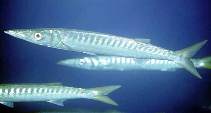| Family: |
Sphyraenidae (Barracudas) |
| Max. size: |
128 cm FL (male/unsexed); max.weight: 8,200.0 g |
| Environment: |
pelagic-neritic; marine; depth range 0 - 100 m |
| Distribution: |
Eastern Central Atlantic: Cape Verde and the Canary Islands. Also reported from Lebanon in the eastern Mediterranean. Its exact distribution and abundance are unknown because most published records do not separate it from Sphyraena sphyraena. Also in Azores Islands (Ref. 44330). |
| Diagnosis: |
Body slender, fusiform with conical, hydrodynamical snout. Mouth long, with low protractile capacity and with prognatic lower jaw, has two rows of long canine-like teeth. Has no scale on preoperculum. Upper half of body has numerous vertical dark bands extending below the lateral line in the anterior part of the flanks (Ref. 44330). |
| Biology: |
Its habits are probably similar to those of the phylogenetically closely related Sphyraena sphyraena (Ref. 6949). Feeds on cephalopods, crustaceans and fishes. Caught in trammel nets and beach seines (Ref. 11101). |
| IUCN Red List Status: |
Least Concern (LC); Date assessed: 14 July 2014 Ref. (130435)
|
| Threat to humans: |
harmless |
Source and more info: www.fishbase.org. For personal, classroom, and other internal use only. Not for publication.
